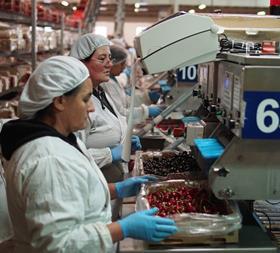
Rising Chinese demand for high value lines such as cherries, blueberries and avocados and continued pressure from the weak euro helped China overtake the Netherlands to become the second biggest market for Chilean fruit last season.
The final results for 2015/16 released by Asoex reveal that together with Hong Kong, China accounted for 11 per cent of Chile’s 2.485m export volume, an increase of 14 per cent on 2014/15.
By region, North America was Chile’s number one market with 32 per cent of the export total, followed by Europe on 22 per cent, Latin America (21 per cent), Asia (19 per cent) and the Middle East (4 per cent).
Overall, Chile’s export volume was up 5.9 per cent on the previous season, with a corresponding value increase of 3 per cent to US$4.717bn.
Apple shipments rose by 14 per cent to 728,177 tonnes, making them the number one export. Grapes were second on 687,802 tonnes, a fall of 9 per cent on 2014/15. Together they accounted for 57 per cent of total exports. They were followed by kiwifruit on 185,271 tonnes (+11 per cent), pears on 126,355 tonnes (-6 per cent) and avocados on 119,887 tonnes (+76 per cent).
Table grapes topped the chart in value terms, with US$1.326bn or 28 per cent of total sales, followed by apples and cherries on 13 per cent and blueberries on 12 per cent. Avocados registered the biggest value increase, surging 77 per cent to US$118m. This was down to the increased volume, as average price levels were similar to 2015/16.
“This is the second consecutive year that exports have risen, although we didn’t reach the 2.654m-tonne record set in 2012/13, after which Chile suffered its worst freeze for 60 years and major flooding to northern zones in March 2015, causing widespread losses to life and homes in the Copiapó Valley and destroying some 1,300ha of grape production,” Asoex president Ronald Bown said.
He noted that exports to all five of Chile’s main markets increased last season. “Shipments to the US and Canada were up 3.4 per cent, while the Far East took 10.9 per cent more fruit, becoming the only market in which there has been sustained growth for more than 10 years,” he said.
Out of Chile’s six largest markets, Brazil registered the biggest growth, with exports rising by 39 per cent. “In spite of Brazil’s economic problems, shipments have increased by 59 per cent over the past four seasons, mainly because of strong apple sales, which over the same period have quadrupled and now make up half of Chilean fruit exports to this market,” Bown said.
The UK market also grew strongly, with shipments climbing 17 per cent compared with 2014/15.
Exports to the US ended the season up 1.7 per cent at 792,640 tonnes. Of this, table grapes accounted for 39 per cent of the total, followed by apples (13 per cent) and oranges and blueberries on 8 per cent respectively.
“Philadelphia and Wilmington were the main ports of entry in the US, together taking 44 per cent of shipments, a 12 per cent increase on the previous season,” Bown said.



